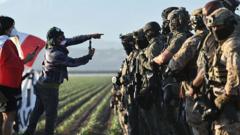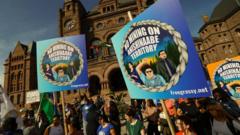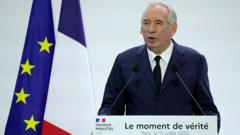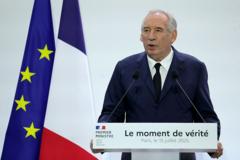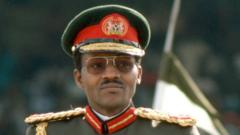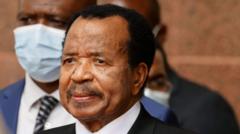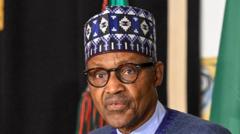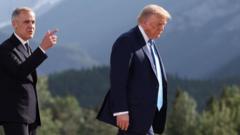In a dramatic shift, the Liberals have surged ahead, but challenges remain as the nation grapples with its identity and leadership landscape.
**Polls Close in Canada: A Pivotal Election Under Global Scrutiny**

**Polls Close in Canada: A Pivotal Election Under Global Scrutiny**
As Canadians cast their votes amid economic turmoil and external pressures, the election results promise to reshape political dynamics.
As the clock strikes 9:30 p.m. ET on April 28, 2025, Canada finds itself holding its breath for election results that promise to significantly affect its direction amidst growing global uncertainties. With most polls closing, voters are in a decisive moment that will reveal whether they lean towards the solidly historical Conservative Party or opt for the progressive imaginings of the Liberal Party, now headed by former central banker Mark Carney.
Pre-election sentiment leaned heavily in favor of the Conservatives, led by Pierre Poilievre, who, only months ago, held a 25-point lead. However, recent developments — particularly President Trump’s hostile trade rhetoric — have shifted the focus onto Carney’s ability to counter U.S. aggression. Political analysts note that this election has become a referendum on Canada’s response to Trump's threats of tariffs and the possibility of annexation.
Voters are now being called to decide who will lead them through these challenges. The other contenders in the fray include the left-leaning New Democratic Party (NDP), the environmentally focused Green Party, and the sovereignty-seeking Bloc Québécois, which primarily represents Quebec interests. While many voters are motivated by broader economic concerns, the pressing question remains: who can best ensure Canada’s sovereignty and economic stability during turbulent times?
The logistics of voting highlight the complexity of Canada’s electoral system. With a total of 343 parliamentary seats, candidates represent individual districts called ridings. As per tradition, counting happens by hand, ensuring a thorough, if time-consuming, tally process. The results will be reported in real time by Elections Canada, adding a layer of tension as citizens await the outcome.
A notable yet cautious perspective arises from the intertwining of leadership identities. Carney, initially known for his economic expertise at prestigious global forums, is now engaging directly with voter concerns, seeking to establish trust after his predecessor's declining popularity. On the other hand, Poilievre's populist approach has resonated with certain demographics, despite his perceived alignment with Trump’s controversial policies.
Moreover, while climate issues drastically shape discussions on a larger scale, they have surprisingly taken a backseat in this election — a point identified by experts who argue that many Canadians prioritize economic stability and national security over environmental strategies.
The results of the election will not merely inform who sits in office; they will reflect the collective Canadian sentiment on sovereignty, economic direction, and global positioning. As the final ballots are cast and counted, eyes will widen to see if Carney’s ascendancy marks a new era for the Liberals against the Conservatives or if Poilievre will reinstate the traditional power of the right.
The unfolding story of this election is poised to redefine a nation at a critical juncture in its history, and as Canadians hold their breath, the implications of their choices extend beyond their borders, resonating with international observers and potentially shaping future relations.
Pre-election sentiment leaned heavily in favor of the Conservatives, led by Pierre Poilievre, who, only months ago, held a 25-point lead. However, recent developments — particularly President Trump’s hostile trade rhetoric — have shifted the focus onto Carney’s ability to counter U.S. aggression. Political analysts note that this election has become a referendum on Canada’s response to Trump's threats of tariffs and the possibility of annexation.
Voters are now being called to decide who will lead them through these challenges. The other contenders in the fray include the left-leaning New Democratic Party (NDP), the environmentally focused Green Party, and the sovereignty-seeking Bloc Québécois, which primarily represents Quebec interests. While many voters are motivated by broader economic concerns, the pressing question remains: who can best ensure Canada’s sovereignty and economic stability during turbulent times?
The logistics of voting highlight the complexity of Canada’s electoral system. With a total of 343 parliamentary seats, candidates represent individual districts called ridings. As per tradition, counting happens by hand, ensuring a thorough, if time-consuming, tally process. The results will be reported in real time by Elections Canada, adding a layer of tension as citizens await the outcome.
A notable yet cautious perspective arises from the intertwining of leadership identities. Carney, initially known for his economic expertise at prestigious global forums, is now engaging directly with voter concerns, seeking to establish trust after his predecessor's declining popularity. On the other hand, Poilievre's populist approach has resonated with certain demographics, despite his perceived alignment with Trump’s controversial policies.
Moreover, while climate issues drastically shape discussions on a larger scale, they have surprisingly taken a backseat in this election — a point identified by experts who argue that many Canadians prioritize economic stability and national security over environmental strategies.
The results of the election will not merely inform who sits in office; they will reflect the collective Canadian sentiment on sovereignty, economic direction, and global positioning. As the final ballots are cast and counted, eyes will widen to see if Carney’s ascendancy marks a new era for the Liberals against the Conservatives or if Poilievre will reinstate the traditional power of the right.
The unfolding story of this election is poised to redefine a nation at a critical juncture in its history, and as Canadians hold their breath, the implications of their choices extend beyond their borders, resonating with international observers and potentially shaping future relations.

